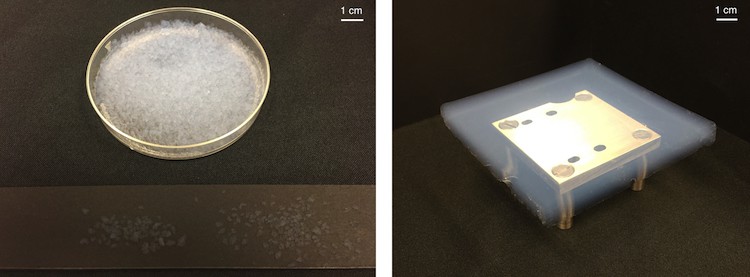Aerogel insulation could provide habitable regions on Mars
18 Jul 2019 Isabelle Dumé
The silica aerogel used in the experiment. Courtesy: Robin Wordsworth/Harvard University
Regions of Mars could be made habitable within decades using current technology. So say researchers at Harvard University, the California Institute of Technology (Caltech) and the University of Edinburgh who suggest warming just certain areas of the planet – using greenhouse-like shields made from silica aerogels – rather than terraforming it entirely.
The surface of Mars is hostile to life as we know it – it is too cold for liquid water to exist and there is no ozone layer to protect it from ultraviolet radiation. Although researchers have put forward many proposals over the years to make Mars more hospitable, all these would require massive environmental modifications. “Such global terraforming will not be possible for centuries, if ever,” says Robin Wordsworth of the Harvard Paulson School of Engineering and Applied Sciences, who led this new study.
Solid-state greenhouse effect
Wordsworth and colleagues have now put forward a new idea: exploiting a solid-state analogue to the atmospheric greenhouse effect here on Earth. This effect occurs when sunlight is absorbed inside translucent snow or ice layers. It is most pronounced in materials that are partially transparent to visible light but have low thermal conductivity and block infrared light. Unlike Earth’s polar ice caps, the polar ice caps on Mars (which contain a combination of both water ice and frozen carbon dioxide) are much too volatile to make robust solid-state greenhouse shields, say the researchers.
They explain that silica aerogels, which contain nanoscale networks of interconnecting silica clusters, contain over 97% air by volume and have some of the lowest measured thermal conductivities of any known material (of 0.02 W/m/K at 1 bar pressure or 0.01 W/m/K at Martian atmospheric pressure). Thanks to these properties, the materials are already routinely employed in many engineering applications, including in NASA’s Mars Exploration Rovers where thin aerogel layers provided night-time thermal insulation.
In their experiments, Wordsworth and co-workers replicated the surface conditions of Mars in the laboratory. They then placed a layer of silica aerogel particles or tiles on a base that reflects little light surrounded by a thermally insulating material. Next, they exposed the apparatus to visible light from a solar simulator. They measured the broadband light flux incident on the aerogel layer using a pyranometer and the temperature with calibrated glass-bead thermistors.
2-3 cm thick silica aerogel layer is enough
Both the aerogel particles and tile layers received visible flux in the 100-200 W/m2 range. To compare, Earth receives on average 342 W/m2 and Mars 147 W/m2.
The team found that a 3 cm layer of silica aerogel can increase the temperature of the underlying surface by 45 K when it receives a flux of 150 W/m2. Aerogel tiles, which transmit more visible light, increase temperatures by a further 10 K, reaching over 50 K at just 2 cm thicknesses.
The researchers say they can obtain warming to 0°C or higher under Mars-like insulation levels using a 2-3 cm thick silica aerogel layer. The maximum amount of warming possible is likely even higher since heat is lost in the experimental set up.
They also measured how much UV light the aerogel and tiles absorbed and found that it strongly blocked UVA and UVB radiation (280-400 nm wavelengths) and nearly totally blocked the most hazardous UVC (220-275 nm) radiation.
“The aerogel is effective at transmitting visible light but blocks infrared radiation and is an extremely effective insulator,” says Wordsworth. This makes it very efficient at warming via the solid-state greenhouse effect, while also blocking harmful UV radiation,” he tells Physics World.
Habitation domes and self-sustaining biospheres
The material could be used as a shield to warm up small, sufficiently ice-rich, relatively dust-free regions of Mars’ surface – to build habitation domes, for example, or even self-sustaining biospheres, he adds.
“There are many mid-latitude locations rich in ground ice and low dust accumulation rates within the latitude band where solar flux is high throughout the year (45°S–45°N). We calculated how the Martian subsurface would evolve using our aerogel for one location (Deuteronilus Mensae).
“Assuming the presence of a 2.5-cm-thick aerogel layer, subsurface temperatures down to depths of several metres are high enough to allow liquid water throughout the Martian year after a few years at this location.”READ MORE

“Small islands of habitability”
“Mars is the most habitable planet in our Solar System besides Earth,” explains Laura Kerber of the Jet Propulsion Laboratory at Caltech. “But it remains a hostile world for many kinds of life. A system for creating small islands of habitability would allow us to transform Mars in a controlled and scalable way.”
The team, reporting its work in Nature Astronomy 10.1038/s41550-019-0813-0, now plans to investigate the response of the aerogel shield to the pressure changes expected to occur on heating the Martian surface. “We also plan to perform field tests in analogue, extreme, environmental sites on Earth, such as in the dry valleys of Antarctica or Chile, to increase the realism of our setup,” says Wordsworth.
There are also the all-important philosophical and ethical questions concerning astrobiological planetary protection that will need to be answered before any such technology can realistically be employed. “If you’re going to enable life on the Martian surface, are you sure that there’s not life there already? If there is, how do we navigate that,” he asks. “The moment we decide to commit to having humans on Mars, these questions are inevitable.”

Isabelle Dumé is a contributing editor to Physics World
FROM PHYSICSWORLD.COM 26/3/2023

Δεν υπάρχουν σχόλια:
Δημοσίευση σχολίου